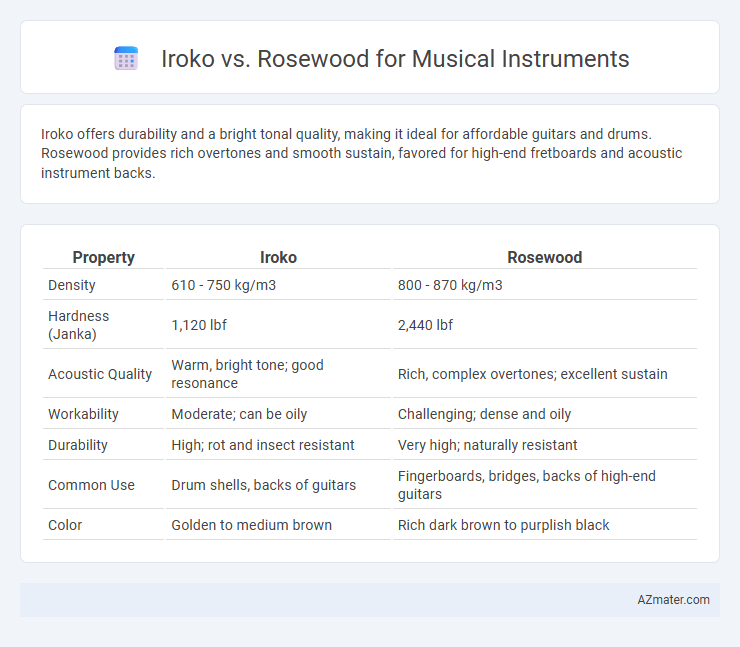Iroko offers durability and a bright tonal quality, making it ideal for affordable guitars and drums. Rosewood provides rich overtones and smooth sustain, favored for high-end fretboards and acoustic instrument backs.
Table of Comparison
| Property | Iroko | Rosewood |
|---|---|---|
| Density | 610 - 750 kg/m3 | 800 - 870 kg/m3 |
| Hardness (Janka) | 1,120 lbf | 2,440 lbf |
| Acoustic Quality | Warm, bright tone; good resonance | Rich, complex overtones; excellent sustain |
| Workability | Moderate; can be oily | Challenging; dense and oily |
| Durability | High; rot and insect resistant | Very high; naturally resistant |
| Common Use | Drum shells, backs of guitars | Fingerboards, bridges, backs of high-end guitars |
| Color | Golden to medium brown | Rich dark brown to purplish black |
Introduction to Iroko and Rosewood
Iroko and rosewood are highly valued tonewoods used in musical instrument construction, each offering distinctive acoustic properties. Iroko, often called African teak, provides a bright, durable sound with excellent sustain, making it ideal for electric guitar bodies and backs of acoustic instruments. Rosewood, renowned for its rich, warm overtones and complex harmonics, is frequently selected for fingerboards, bridges, and guitar backs, prized for enhancing tonal depth and resonance.
Historical Use in Musical Instruments
Iroko and Rosewood have been historically prized for their tonal qualities and durability in musical instrument craftsmanship. Rosewood, especially from species like Dalbergia nigra, has long been favored for high-end guitars and pianos due to its rich, resonant sound and attractive grain patterns. Iroko, often used as a sustainable alternative to Rosewood, provides a bright tone and strong structural integrity, making it popular in African drums and certain string instruments where durability and sound clarity are essential.
Physical Properties Comparison
Iroko wood features a Janka hardness of approximately 1,260 lbf, offering moderate durability and resistance to wear, while Rosewood, particularly Brazilian Rosewood, exhibits a higher Janka hardness around 2,440 lbf, making it significantly denser and more resilient. Iroko's grain is coarse and interlocked, providing good stability and dimensional strength, whereas Rosewood is prized for its fine, oily texture and natural oils that enhance moisture resistance and longevity. Both woods offer favorable acoustic properties, but Rosewood's greater density contributes to richer tonal depth and sustain in musical instruments.
Tonal Characteristics of Iroko vs Rosewood
Iroko wood offers a bright, punchy tonal profile with clear midrange frequencies and moderate warmth, making it suitable for guitars and ukuleles that require articulation and projection. Rosewood features a rich, complex tonal character with pronounced bass response, sparkling highs, and a smooth sustain, preferred for its depth and resonance in high-end acoustic instruments. The choice between Iroko and Rosewood significantly impacts the instrument's voice, with Iroko favoring clarity and Rosewood emphasizing warmth and harmonic complexity.
Workability and Craftsmanship
Iroko offers excellent workability for musical instrument makers due to its medium density and straight grain, allowing precise carving and shaping with minimal tool wear. Rosewood is highly prized in craftsmanship for its rich tonal qualities and smooth finish, but its dense, oily texture demands sharp tools and experience for fine detailing. Both woods require skilled handling, yet rosewood's superior resonance and aesthetic appeal often justify the increased effort in crafting high-quality instruments.
Durability and Longevity
Iroko and rosewood both offer exceptional durability for musical instruments, with rosewood renowned for its dense grain that resists wear and enhances tonal quality over time. Iroko, often dubbed "African teak," exhibits strong resistance to moisture and decay, making it a preferred choice for instruments in humid environments. Rosewood's longevity is notable in its ability to maintain resonance and structural integrity for decades, whereas iroko provides a robust and stable sound profile with slightly less density but increased resilience against environmental changes.
Sustainability and Environmental Impact
Iroko wood is considered more sustainable than rosewood due to faster growth rates and wider availability, reducing pressure on endangered species. Rosewood, often sourced from slow-growing tropical trees, faces significant restrictions and bans under CITES regulations to prevent overharvesting and habitat destruction. Choosing iroko for musical instruments supports eco-friendly practices by minimizing environmental impact while maintaining durability and tonal quality.
Cost and Availability for Luthiers
Iroko offers a cost-effective alternative to rosewood, with prices significantly lower due to its abundant availability in West Africa, making it a popular choice among luthiers seeking affordability without sacrificing tonal quality. Rosewood, prized for its rich, warm sound and durability, commands higher prices because of restricted trade regulations and overharvesting concerns, leading to limited supply and increased sourcing difficulties. Luthiers prioritize Iroko when budget constraints and material accessibility are critical, while rosewood remains preferred for premium instruments despite its cost and scarcity.
Popular Instruments Made with Iroko and Rosewood
Iroko is commonly used in electric guitar bodies and drum shells due to its durability and bright tonal properties, making it popular in modern instrument manufacturing. Rosewood is highly prized for fretboards, acoustic guitar backs, and classical guitar sides because of its rich, warm sound and smooth feel. Both woods contribute unique acoustic qualities, with rosewood favored for rich resonance and iroko chosen for its balance of strength and clarity.
Choosing the Right Wood for Your Musical Needs
Iroko and Rosewood both offer distinct tonal qualities for musical instruments, with Iroko providing a bright, warm sound and excellent durability, making it ideal for electric guitars and drums. Rosewood is prized for its rich, complex overtones and smooth sustain, commonly used in acoustic guitars and fretboards for its superior resonance and playability. Selecting the right wood depends on the desired sound profile, instrument type, and budget, with Iroko serving as a cost-effective alternative to the more expensive, tone-rich Rosewood.

Infographic: Iroko vs Rosewood for Musical Instrument
 azmater.com
azmater.com